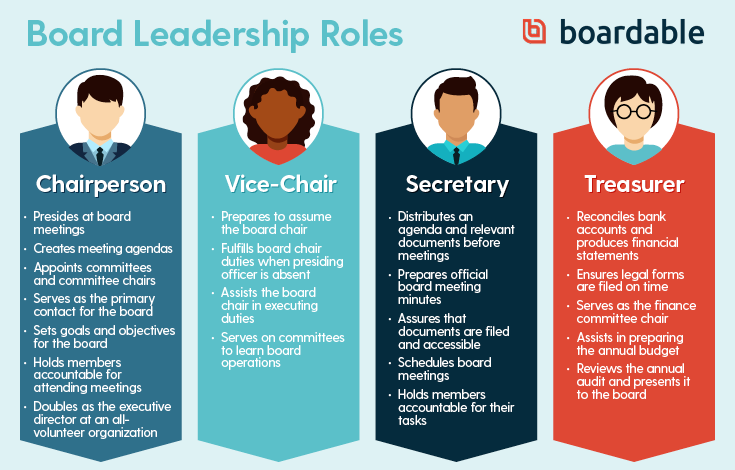
Anyone who’s ever worked at an organization understands that the board of directors holds a lot of power. As the governing entity for your organization, they’re responsible for making decisions regarding your strategic direction, budgeting, and programming. Because of the crucial importance of the board’s work, you want exceptional leaders at the helm to guide your organization along the correct path.
If you’ve worked with your organization’s board for any amount of time, you know that you have a specific group of leaders among your board known as your officers who make up your executive committee. Understanding who your board officers are and how you can set them up for success is a vital part of managing a board.
Executive directors and other board members are all instrumental in creating a solid leadership structure that allows the board to complete its work as efficiently and effectively as possible. To help you develop a trustworthy leadership team, this quick guide will explore these key areas:
- Common Board Officer Roles
- Tips for Training Your Board Officers
You want your organization to be in the best position possible to succeed, and that all starts with putting the right leadership structure in place. Let’s dive in!
Common Board Officer Roles
While organizations vary in their missions and strategies, most typically follow a similar board leadership structure. Boardable’s guide to executive committees explains that there are typically four positions that the board collectively elects and votes leaders into the chair, vice-chair, secretary, and treasurer.
This group forms the executive committee, which “acts as a steering committee for the full board… It prioritizes issues for the full board to address, is responsible for overseeing board policies, and must ensure good governance practices.”
Larger organizations may have other roles as part of the executive committee, but these are the key ones for virtually any organization. Let’s take a closer look at these positions, related responsibilities, and what skills help individuals perform well in these roles.

Chair
Think of the board chair (also called the president) as the head of your board leadership team. This individual manages some of your board’s most important activities, including running meetings and serving as a key point of contact for board members to turn to for information.
In addition, the board chair:
- Presides at meetings
- Appoints committee chairs and members
- Works closely with the executive director to ensure any actions the board takes to align with the organization’s bylaws, objectives, and mission
- Serves as primary spokesperson when speaking to the press, media, and other external groups
As such a visible and central leader, your board chair requires a specific set of skills and characteristics to succeed in the role. For one, they must be highly organized and proactive to keep meetings running smoothly and maintain a high level of productivity. Also, these leaders should be well-versed in the art of collaboration and compromise to help board members reach consensus whenever disagreements arise.
Vice-Chair
The vice-chair (which goes by many names, including the vice president, co-chair, and chair-elect) is next in command to the chair. Consider this individual as being in training to become the chair. They primarily assist the chair with their duties, with the ultimate goal of one day stepping into that position.
To fulfill this role, the vice-chair takes on these tasks:
- Fills in during meetings when the chair isn’t present
- Helps the board chair complete his or her long list of responsibilities
- Chairs ad hoc committees/task forces
- Serves on various committees to learn about various aspects of the board’s operations
As the board chair’s right hand, the vice-chair should embody many of the same qualities as the board chair themself, including strong organizational, leadership, and communication skills. When your organization enters a busy season, your vice-chair can provide the support your chair needs to keep your board and entire organization on track. This individual should work well with your chair to ensure harmony at the top leadership level.
Secretary
The secretary is another well-known position on the executive committee. This person is primarily charged with maintaining your organization’s documentation. While many think of this individual as the designated note-taker for meetings, the role entails more than taking minutes (although that is a major responsibility).
Here are the typical responsibilities of a board secretary:
- Records and distributes board meeting minutes
- Schedules board meetings
- Tracks board members’ terms to maintain the successful rotation of members
- Maintains an event calendar for the board
- Ensures all board members can access necessary documents
- Helps develop an orientation process and assists in onboarding new board members
The number one skill of any effective board secretary is strong communication. Your secretary will have to be closely tuned into your board meetings to identify key information and summarize extensive conversations. Not to mention, this person should be highly organized as they’ll be in charge of keeping all documentation tidy.
Your board secretary should also have a strong background in your organization’s structure and history. This will allow them to be a resource when other board members have questions about processes or discussion items.
Treasurer
All things related to your organization’s finances fall under the treasurer’s umbrella. This primarily means creating budgets and making decisions regarding your organization’s spending.
The treasurer also takes on these responsibilities:
- Chairs the finance committee
- Acts as a signatory on the organization’s bank accounts (not the case for all organizations)
- Assists in preparing the annual budget and presenting it to the board for approval
As the person who handles budgeting and other financial considerations, your treasurer should have some level of experience working with accounting. However, the most important trait your treasurer should exhibit is trustworthiness. You should be able to rely completely on your treasurer to make smart decisions and recommendations when it comes to your organization’s financial situation.
Tips for Training Your Board Officers
One of the greatest aspects of serving on a volunteer board is that board service is open to people who come from a wide variety of backgrounds. However, one caveat to this is that members may lack the necessary expertise to excel in their position without extra support.
Serving as a board officer is a learning experience, so you should offer plenty of training opportunities to expedite your board’s growth. Here are a few training opportunities to offer board members:
- A comprehensive onboarding process. Similar to when you onboard brand new board members, you’ll want to train newly elected leaders. Your onboarding experience should walk new officers through the expectations and responsibilities of their new roles as well as set the calendar of upcoming executive committee meetings. You should allow your new officers to ask questions, get to know one another better in a collaborative environment, and get comfortable with any new procedures and processes they’ll have to follow.
- Continuing education opportunities. Leaders strive to continue learning. Offer all of your board members ongoing training opportunities like e-courses and in-meeting training sessions that engage them and inspire growth. This helps board members sharpen their leadership skills and reach their full potential, even if they haven’t stepped into a leadership role yet.
Make sure to offer virtual training opportunities for board members who prefer to participate remotely. Re: Charity’s virtual board meeting guide recommends using video chatting software and establishing video meeting etiquette guidelines to make the most of these online gatherings.
If you aren’t sure if you’re offering the best training options, you can send out occasional surveys or assessments to measure members’ satisfaction and the effectiveness of your training opportunities. Use the results of these surveys to adjust your training approach to meet board members’ needs more successfully in the future.
Final Thoughts
Your board leadership defines your entire board’s efficiency and effectiveness. Make sure you choose the right individuals for each role and offer plenty of training opportunities to fully prepare them to exceed expectations and lead your organization along the right path. It may take some trial and error, but with patience, you’ll eventually develop a standout team of board officers!




